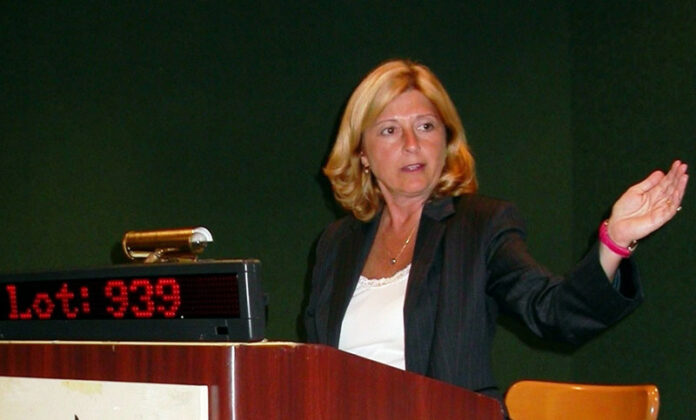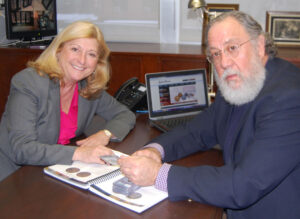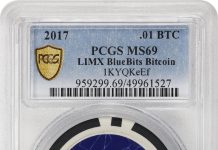
Christine Karstedt is Executive Vice President of Stack’s Bowers Galleries and has been a fixture at coin conventions and auctions for over 25 years. She is well known at the podium as a licensed auctioneer and has personally attended nearly every sale hosted by Stack’s Bowers Galleries and its preceding firms.
How did you get involved with Stack’s Bowers Galleries?
I met Dave Bowers when his son, Andrew, and my daughter, Melissa, were four years old at the Wolfeboro Nursery School. Dave had moved here in 1980 to launch Bowers and Merena Galleries and my family moved to town in 1981.
In my past life, I taught high school science but took time off to raise a family. Dave had commented that his business was growing and needed some help. I volunteered to come in to open the mailed bid sheets and help where I could. Back then, we still processed bids by hand, taking each bid sheet and recording them in giant three-ring binders for each session. We would use these binders during the auction to open each lot and record the closing hammer price and bidder number.
I then started helping Dave when he was cataloging, via dictation, marking lots for photography, ordering the sale and final lot numbering, then traveling to auctions.
Do you consider coin collecting and investing to be mutually exclusive?
That is a loaded question. If you were collecting State Quarters, the answer is more “yes” than everyone had hoped when the State Quarter program rolled out. If you are talking about classic numismatic collections, the adage, “patience is a virtue,” is an important consideration.
There have been very few times when you could build a meaningful collection and turn it into a profit in a short period.
To be successful, it’s important to take some time to find a series that fits your budget and that is appealing to you either because of its design, history or some other aspect. Then take some additional time to learn about the series or find a trusted advisor to get you started.
Let’s remember that the Mint is not adding to the population of Buffalo nickels, Mercury dimes, Standing Liberty quarters, or Walking Liberty half dollars, not to mention Colonial coins or large-size paper money. Choosing to build a collection in one of those areas, should bring you a positive return on your investment over time.

COURTESY STACK’S BOWERS
What do you like best about working with collectors who are building registry sets?
I have always been a big fan of these programs, as they offer almost everything a collector needs from start to finish. First, there is a checklist of what is required to complete a set and different options are given within a particular series. It also provides the same satisfaction of “filling a space” that the old albums used to give.
The set registry programs allow collectors an avenue to share the pride of ownership and accomplishment with their peers in a safe environment, while the collection remains safely stored in a bank vault. Plus, they give collectors a way to satisfy a sense of competitiveness to finish a collection before someone else or improve its rank. You couldn’t ask for more.
Are coin conventions slowly fading from the scene?
Over the last 40 years, numismatic conventions have gone through metamorphic changes. We’ve seen some of the older shows fade away; then a resurgence in the number of shows including some new venues; then the addition of pre-shows to major conventions; then the loss of pre-shows; and, now, the change in convention attendance because of the pandemic.
Collectors are a social bunch, and while the main purpose for attending a show may change and fluctuate over the years, there will always be a core group of shows providing opportunities for clubs to meet, educational exhibits, information seminars and the enjoyment of gathering with people who have like interests.
What needs to be done to expand and grow the hobby with young people?
This question has been asked for decades and I am sure it will continue to be asked in the future.
Many, especially those of us who are a little older, remember fondly, and possibly with rose-colored glasses, the old times when families would attend conventions. Children, newly fascinated with collecting, would leave with a penny board to fill up at home, giving them a lifelong love of coins. But, let’s face it, numismatics has changed tremendously and that scenario is not going to return if it was ever really true.
I’ve been in the business for decades, and if no one had joined the hobby in that time, collecting would already be dead. Many new clients are coming in.
They may not be 20 years old, but they are new, and the industry is as healthy as ever.
Maybe these “new” people didn’t get hooked as children but they are as passionate as ever, whether they caught the bug as a teenager, in middle age or as a retirement venture. Numismatic companies and organizations have a long history of supporting educational displays, mainstream marketing for the public, and a welcoming persona in local clubs and at conventions. We should continue to do this, welcoming people of all ages and sharing our enthusiasm for this great hobby.
This article about Christine Karsredt previously appeared in COINage magazine. To subscribe click here. Article by Scott A. Travers.











